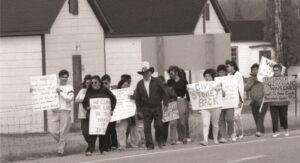Ipperwash Summer Series: Community plans honour longstanding connection to Aazhodena
September 6, 2020, will mark the 25th anniversary of the shooting death of unarmed protestor Anthony “Dudley” George by an Ontario Provincial Police sniper at Ipperwash Beach. The Anishinabek News will feature an Ipperwash Summer Series to highlight the history, trauma, aftermath, and key recommendations from the 2007 Report of the Ipperwash Inquiry. First Nations in Ontario understood that the Inquiry would not provide all of the answers or solutions, but would be a step forward in building a respectful government-to-government relationship.
For information on the 2007 Report of the Ipperwash Inquiry, please visit: http://www.attorneygeneral.jus.gov.on.ca/inquiries/ipperwash/closing_submissions/index.html

By Nicole Latulippe
It has been 78 years since the Department of National Defence for the Government of Canada expropriated land at Aazhodena (Stoney Point) for military training under the War Measures Act. After waiting for the promised return of land, a group of community members reinhabited the territory on behalf of the community in 1993. They have been there ever since.
Land protectors have been living in the old army barracks, in conditions Chippewas of Kettle and Stony Point First Nation Chief Jason Henry describes as substandard and deplorable. Leaky roofs and asbestos are prevalent in the dilapidated buildings, overlooked says the Chief, by both the First Nation and Canadian federal governments for the last 25 years.
Today, the Chippewas of Kettle and Stony Point First Nation (KSP) is focussed on improving living conditions and community growth at Aazhodena.
With a current focus on housing, the community in partnership with the Department of National Defence will begin to build infrastructure, including watermains, wastewater collection, electricity, roads, and homes. The new neighbourhood design is scalable, meaning that it will first be developed to accommodate community members living in the barracks since 1993. It will then be expanded to accommodate those who choose to move back; that is, “to reinhabit what our grandparents lost 80 years ago.”
The first phase of what Chief Henry termed “moving home” is now underway. Separation from the land has hurt the community, but the longstanding connection to territory is not lost and certainly not forgotten. Oral history and archeological evidence establish 8,000-10,000 years of habitation at Aazhodena, including sites of transportation and commerce along the Nogawe Ziibi (Ausable River). By reinhabiting the land, “our people will grow stronger as a sovereign nation,” the Chief explained, “because as Anishinaabe, we know that our connection to the land ties back to our Creation story, where our people originated from.”
While the former Ipperwash Provincial Park lands are in the late stages of the lengthy Additions to Reserves (ATR) process, the ATR process for the former Camp Ipperwash has not yet begun. Due to environmental contaminants, unexploded ordinances, and other environmental concerns, an estimated 20 years are required to clean up the entire area. The Government of Canada holds a legal obligation to complete this work, and they are now working with and investing in KSP in ways that meet community needs—particularly in housing and development, areas that are being fast-tracked by the First Nation.
This partnership marks a sea change in relations with Canada. From an adversarial position since 1942, KSP and the Department of National Defence have been building a relationship since the 2016 signing of The Ipperwash Final Settlement Agreement.
The vision shared by Chief Henry is one of community growth, healthy and sustainable living, business creation, a thriving economy, and reattachment to the land. The community is developing a joint venture to create business opportunities for contracting in the nation. It will support community entrepreneurs working on clearance and remediation in the territory and grow local expertise in the environment, unexploded ordinance removal, contract management, and housing development over a number of years. The aim is to create an economy for community members in the restoration of the land.
The vision is clear: plans for Aazhodena honour the connection held over millennia between the people and the land.
Nicole is a guest on Mississauga Anishinaabe treaty territory and gathering place of many nations. She writes and teaches geography and environmental studies at the University of Toronto Scarborough.

